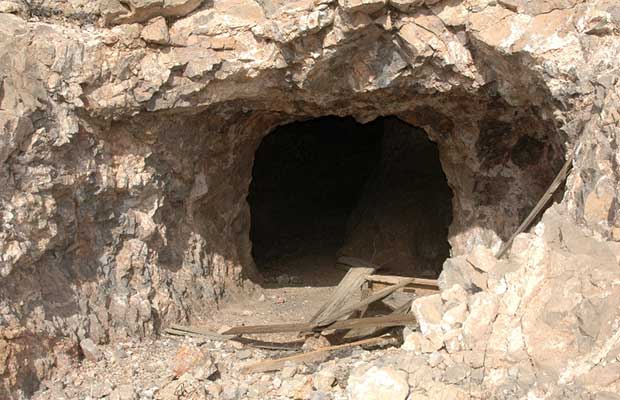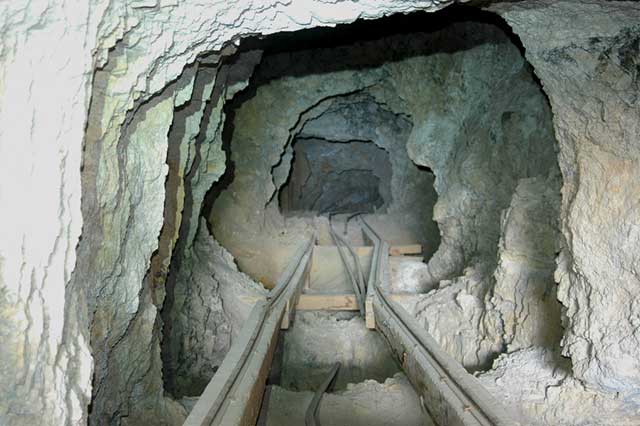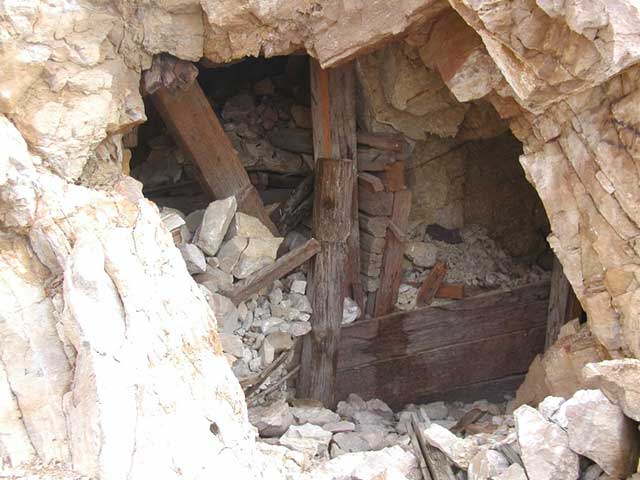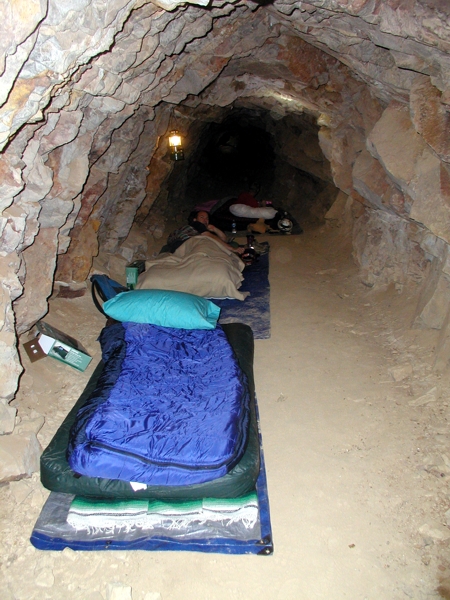
Caching Supplies
There are numerous articles dealing with the caching of supplies on this and other Prepper sites. Within the context of abandoned mines, my principal suggestion is to evaluate caching locations that are not in the immediate vicinity of the mine workings. The simple reason as that recreationists visit abandoned mines and there is no point in setting a cache that can be discovered by people wandering around the site.
By most definitions, abandoned mines are located in and surrounded by rugged terrain. That gives you virtually limitless ways to conceal a cache that no one will ever find. Take your time. Plan the cache with an eye toward a secure location. One suggestion would be to set the cache some distance beyond the primary point of interest. Most casual visitors are only interested in seeing and photographing a historic mine site; then they are on their way. Mines that are more distant from well traveled 2-tracks, or that are not visible will be less frequently visited.
Planning Considerations
Out of 400 nearby mines, there are twelve sites on my preferred-use list if circumstances require that I abandon my home. A far greater number are ‘workable,’ but not desirable. Even where the use of 4WD is necessary, I can reach any of these twelve locations without consuming more than a quarter-tank of gas. Some are more difficult to reach than others. Some offer superior defensive advantages. Some are more suitable for long term occupation than others. Nevertheless, I would not hesitate to use any of these sites should the situation require it.
It is my choice to stockpile fuel reserves on my property, rather than near the mine site. Simply stated, they are all viable and I cannot predict which of these dozen sites I would want to use in a SHTF situation. I’m fortunate because I have a multitude of choices, but it is impractical for me to preposition fuel and other supplies at or near that many sites. Your options may be better or poorer than mine.
Here are some suggestions that you should factor into your planning:
- It is reasonable to assume that you will not be the only one to discover a prospective mine site retreat. You should, therefore, assess several sites.
- He who controls the high ground controls the land, especially in a SHTF situation. If the first to arrive is not you, then you will need an alternate location that is still within your driving range.
- The drive distance from your home to an abandoned mine may be considerably greater than mine, and the difficulty in reaching your site may be compounded by circumstances that are entirely unpredictable. Effective resource planning dictates that you include considerations for fuel and other basic needs along the way, not just at your chosen destination.
- A secure retreat does not necessarily require extensive space. Mine adits may be only a few feet wide, but can still provide hundreds of linear feet of usable area for a group.
- Planning factors for situating a camp site within an adit should consider the availability of light. Mines interiors are dark places.
- You want to be able to utilize as much ambient light as possible during daytime hours. Thus, an east or west facing adit will maximize the availability of light. South facing adits may be favorable during winter periods.
- You will want to be forward toward the entrance during daylight hours.
- Regardless of the time of day, cooking and warming fires should be set as far back from the entrance as is practical.

This adit is entirely unusable. A lower level stope has penetrated the adit floor from below and ore car tracks obstruct any possible use of the floor. Discussion of other characteristics are irrelevant.
The thought here is that you need to evaluate the availability of morning and afternoon light, the direction and flow of air in the adit, as well as the structural space where fires might be best located.
- Adits that have no air flow will require that your fires be located at, or outside of, the entrance. Depending on the terrain, you may still be able to use these sites. (More on that subject in the section that follows.) An example would be an adit that is situated near a wash, but that is surrounded by steep terrain.
- Campfire resources are generally abundant in the mountainous regions of the western U.S. Whether the fuel source is pine at higher elevations, creosote or mesquite at lower elevations, you should be able to locate fuel sources within a short distance of the adit. This has several practical applications. Foremost, it allows you to conserve your use of propane or other gas canisters. Second, the adit enables you to collect and store a significant volume of fuel that can be kept dry and hidden from view. Regardless of your resources, plan to keep your fires as small and concealed as possible. Avoid wood that generates a lot of smoke. If you are not familiar with fuel resources in the area, you may have to experiment.
- Determine a safe way to dispose of ash and residue from cooking and warming fires. Do not plan to use an interior shaft for disposal. Shafts, winzes and stopes often contain very significant amounts of timber, and careless disposal of coals and embers can ignite a fire that could burn for weeks. Remember, ventilated mines will have a constant (and sometimes substantial) flow of air, and fire loves oxygen. Visualize a brilliant cone of flame erupting from a shaft and a column of smoke that is visible from great distance. I guarantee you this will get the attention of any functioning government in your area.
- Expect that your source of water will be some distance from the adit. Supplying your daily water needs will likely require transporting containers on a daily basis, either on foot or by use of a vehicle, between the source and the camp. Obviously, large groups consume more water, thereby increasing the frequency and/or volume needed for resupply. Anticipate your need for water based upon the group size, as well as the risk of exposure while you are replenishing your needs.
- Frequent resupply trips will increase your exposure. What if an unknown group suddenly sets camp next to the source? Can you wait them out?
- Anticipate that all sources of water will require some from of treatment to kill or remove harmful organisms.
- Even short term occupation of a mine adit requires that you consider the need for sanitation. You will need to provide some means of accommodating and disposing of human waste. A shaft or winze may be a tempting place and convenient place to dump bagged waste, but avoid it if at all possible. Bury your waste away from the adit. In any case, will want to have a portable potty somewhere in your camp. Enough said.
- As the accompanying photos show, most adits will have moderate to extensive debris in the form of dirt, rocks, trash and (possibly) timbers inside the passage. If you plan to occupy your chosen site for any length of time, you should plan to clean out the area where you will set camp. Constant back and forth movement will kick up dust and other irritants that will settle on your sleeping and cooking areas. In any case, a clean camp is good for morale. You will probably have the option of deciding where you want to move dirt and debris; that is, outside the entrance or farther back in the adit. It’s your choice. Prevailing air flow (inward or outward) may help that decision. If there is an interior winze or shaft, I would opt for dumping it to a lower level. The obvious reason is that it reduces your outside activity and minimizes the risk of detection. Resist any temptation to clean out the entrance of an adit once you have selected it, but before it becomes necessary to occupy it. Leave it in its original state. There is no point in making ‘your’ adit more attractive and easier to occupy by someone else. Don’t forget to bring a broom.

This photo illustrates another adit that is unsafe to enter. Note the collapsed post and cave in. The structural integrity of this mine is zero.
Locating and Evaluating a Mine Adit Site
There are several factors for determining whether any mine site is suitable for your needs. I have compartmentalized them into a series of S’s, followed by bullet notations. These lists are by no means comprehensive. They represent my best effort for a geographic environment that I am most familiar with. Hopefully, they will be useful and inspire you to consider issues that are unique to the locale that you would consider.
Evaluating Seclusion
- Remote, secluded mines are less likely to be visited.
- The less well known they are, the less likely that someone will view them as desirable SHTF retreats.
- Mine sites that are unnamed on geological survey maps are generally preferable to named mines that were historically significant.
- Other, more secluded mine workings will be located near sites that are shown on maps. Many prospect adits are not recorded on current or older versions of maps.
- Mine sites that are protected (by favorable terrain features) from long distance surveillance are desirable. In other words, your candidate site may not be visible at close range due to ground slope or intervening vegetation, but can be seen from two or three miles away at a high point, such as a mountain pass.
- A corollary to the above statement is that elevated mine sites may be detectable from some distance, but the trail leading to them may not be obvious at the viewer’s angle and distance. The point is that as long as there is no easily discernible way to reach an abandoned mine site, the risk of compromise may remain low. You must evaluate these potential exposures.
- Mine sites that are situated low on hillsides, or that are surrounded by steep, unapproachable ground can offer ideal seclusion, but may provide little advance warning of an approaching vehicle or group.
- In desert areas, concealment is easier to achieve where mines are located near washes. The simple reason is that they can support large stands of dense brush and trees.

This photo illustrates how an adit cans be used for camping. Note that the adit is not particularly wide and the ceiling is of moderate height. You can more through the area without crouching.
Evaluating Security
- Do not rely on the mine adit as your sole defense point.
- Set surveillance LP/OP points that maximize your awareness of approaching vehicles or groups.
- Select a site that is defensible. Evaluate and select defensive positions that can be reached day or night.
- If you cannot maintain around the clock surveillance, make the approach to your site as difficult as possible.
- If you have the means, utilize motion detection and/or noise producing trip-wire devices on trails leading to the adit.
- Utilize two-way radios for communication between the adit LP/OP sites and other outlying security points, but avoid standard GMRS/FRS frequencies that are available on common walkie-talkies. Use the minimum wattage needed to maintain reliable communication. Programmable dual band (VHF/UHF) radios are available at a modest cost and feature selectable power output and switchable antennas. Equipment of this type enables you to have your own SHTF frequencies.
- When using radios, do not give specific geographic references that would help someone locate your site.
- Minimize outside activity.
- In the Southwest, 2-track roads and trails are frequently forced to use long stretches of dry washes. These serve to confine approaching vehicles.
- Empty food cans that are suspended on a line can be used as a type of trip wire warning system. This may be a useful tool that alerts you to approaching foot traffic. Be innovative and put resources to their best use, even if you would ordinarily think of it as trash.
- An important factor that bears on site security is having a place to conceal your vehicles. You will want them nearby and visible to you, but not to others. Anything you can do that breaks up the profile and that masks color and reflective components is useful. The solution may require one or more of the following options:
- Cover the entire vehicle with dark blankets, topped off with camouflage netting or parachute material.
- Park next to or behind an existing structure, such as the wall of a building.
- Clear an area in thick brush that is large enough to park.
Frankly, it is advisable to use option ‘a’ plus whatever other means are at your disposal. Shiny reflective surfaces, such as chrome bumpers, wheels and windshields can reveal the vehicle’s location, even at night. Your objective is to be a hole in the dark.
Evaluating Sustainability
- No site, regardless how physically secure it may be, can fulfill your needs without water and food.
- Sources of water that I have found near mine sites include:
- Springs
- Surface streams
- Livestock water tanks (earthen water catchments) that are seasonal
- Shallow wells at the mine site (frequently with a rock or concrete collar)
- Working windmills that provide continuous flow to a metal tank or cistern
- Wildlife water catchments, sometimes referred to as “guzzlers,” may have been established by the BLM or a state Game and Fish agency in some areas near mines. Some will be marked on geological survey maps if they predate publication.
- Hunting can supplement your food stocks, but wild game can be rapidly depleted. Sustained human activity in any area will cause game to disperse.
- As you evaluate various mine sites and the natural resources that are locally available, you will inevitably be forced to determine two vital facts:
- What size group is needed to provide essential security, food and water gathering, and camp maintenance? Will the necessary sustaining activities at this location require more people than you can muster?
- What size group will the adit and local resources support? Will the adit accommodate 20 people, yet locally available water is only sufficient to sustain half that number?
These are tough questions, but they must be answered with absolute objectivity.
Evaluating Safety
- Adits that are at or very near the margins of a wash may be subject to episodic flooding. The presence of silt on the mine floor will confirm whether flooding has occurred in the past.
- Determine if there is plant debris high up in trees or brush near the adit entrance. This will provide a good indication of the high water mark from the most recent storm.
- Narrow washes that pass through steep terrain can experience catastrophic flows, particularly during monsoonal storms in the Southwest. I have found high water marks that were 10 feet or more above the top of an adit.
- Mine entrances that have the appearance of partial collapse are inherently unsafe and will be beyond your ability to repair.
- Before entering the adit, examine the area above the entrance. Is there loose material that could fall onto the mine opening?
- Assessing the safety of an adit will require that you illuminate and thoroughly examine the entire interior structure.
- Use high lumen flashlights and a continuous ‘look-ahead’ method so that you are constantly aware of what is in front of you.
- Begin your evaluation by determining if there is any wildlife present.
- Next, study the floor to identify open winzes, shafts or stopes that penetrate the adit floor.
- Determine if the floor is wet.
- Repeat this process by thoroughly examining the ceiling of the adit. Identify any raises that lead to an upper level. Assess the character of the rock. Is it highly fractured? Are there large sagging boulders extending downward from the ceiling?
- Evaluate all timber structures (posts and caps) in the interior. Wet or collapsed timbers should be viewed as an indicator of risk.
- The absence of posts and caps in an adit is an indicator of the stability of the country rock. Adits that have many posts and caps, or that are covered with a roof of planking suggest a high degree of overhead sloughing.
Concluding Thoughts
Over the course of 30+ years of exploration, I have lost count of the number of mines that I’ve entered. I have also lost count of the number that I refused to enter for safety reasons. The notion of entering an abandoned mine – much less living in one for a period of time – may be intimidating to many people. They are dark and mysterious places where unseen dangers (real or imagined) may lurk. It is unfamiliar ground to the vast majority of people. Nevertheless, the contemplation of extreme events, particularly if they threaten your survival, can challenge you to examine options that you would not ordinarily consider.
As a Prepper, you contemplate potential risks and choose to deal with them in a proactive manner. You understand that mere reaction is often inadequate and that it is never preventative.
Hopefully, this article series has provided you with information and tools that you had not previously thought about. I cannot say that using an adit will work for you, but this primmer can get you started on a safety-based course of study and evaluation that can give you the answers you seek.
I welcome in your observations and questions on this topic. Drop me a note any time.




















